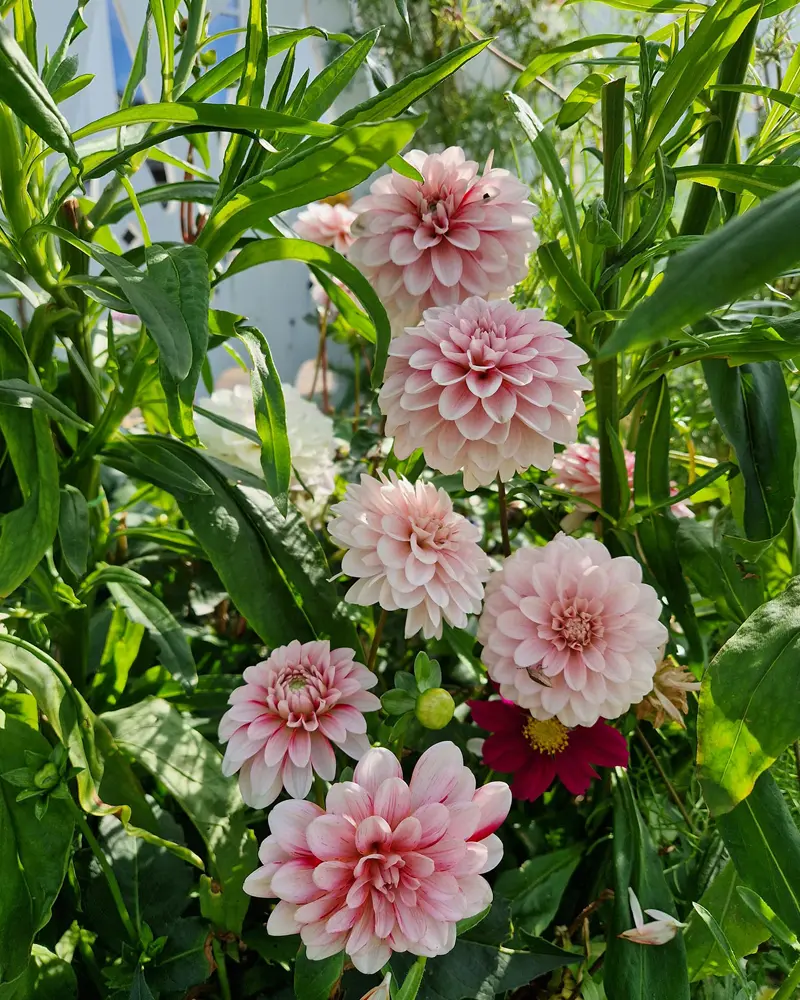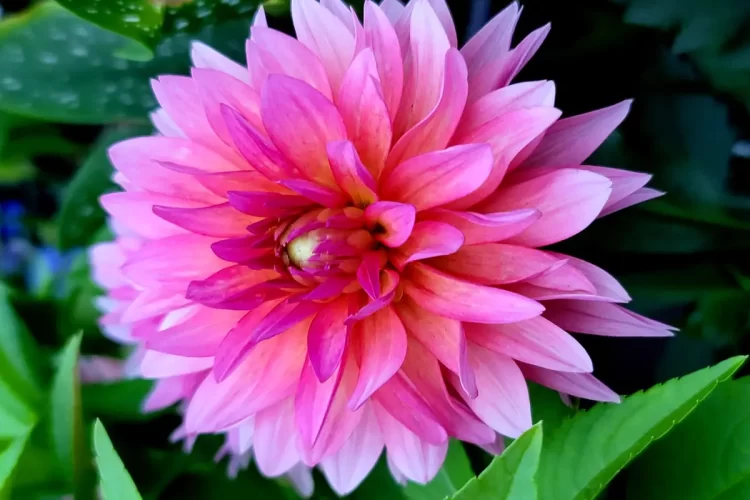Dahlias are a spectacular addition to any garden, known for their breathtaking blooms and wide variety of colors and shapes. Originally from Mexico, these flowers have won hearts worldwide with their striking beauty and versatility. Whether a novice gardener or a seasoned green thumb, this comprehensive guide will equip you with everything you need to know to grow, care for, and enjoy dahlias in full bloom. Let’s dive into the best practices for cultivating these stunning flowers in your garden.
Understanding Dahlias: Types and Characteristics
Dahlias belong to the Asteraceae family and come in numerous forms, sizes, and colors. From delicate pom-poms to large dinner-plate varieties, there’s a dahlia type for every preference. Dahlias can range in height from under a foot to over 6 feet, and their blooms can vary from 2 inches to over a foot in diameter.
Popular Dahlia Types
- Dinner Plate Dahlias: These dahlias are famous for their enormous blooms, often over 10 inches wide, adding a bold statement to any garden.
- Pom-Pom Dahlias: Known for their small, perfectly round blooms, pom-pom dahlias are a compact choice and work well in borders or flower arrangements.
- Cactus Dahlias: With spiky, narrow petals, cactus dahlias offer a unique texture and come in a range of vibrant colors.
- Ball Dahlias: Round and full, ball dahlias have layered petals that make them ideal for cutting and arrangements.
- Single Dahlias: Simple yet elegant, single dahlias have a single row of petals and often attract pollinators like bees and butterflies.
Choosing the Right Location for Dahlias
Dahlias thrive in full sunlight and require at least 6 hours of direct sun daily. They perform best in well-drained, fertile soil and are generally planted in the spring after the danger of frost has passed.
Soil Requirements
- pH Range: Dahlias prefer slightly acidic to neutral soil, ideally with a pH of 6.5 to 7.0.
- Soil Quality: Well-draining, loamy soil enriched with organic matter like compost is ideal. Poorly drained soil can lead to root rot, which is a common problem for dahlias.
Climate Considerations
Dahlias thrive in temperate climates and are sensitive to frost. In USDA zones 8-10, dahlias can survive as perennials, while in colder zones, they are grown as annuals or their tubers are lifted and stored for the winter.
How to Plant Dahlias

Planting Dahlia Tubers
Dahlias are usually grown from tubers, which are planted in the spring after the last frost.
- Prepare the Soil: Loosen the soil and mix in compost or well-rotted manure to enrich it.
- Dig the Holes: For large dahlia varieties, dig a hole 6-8 inches deep and about 12 inches apart. Smaller varieties can be spaced closer together, around 9-12 inches apart.
- Position the Tubers: Place the tubers horizontally with the “eye” (small bump) facing up. Cover with 2-3 inches of soil initially.
- Staking (for Taller Varieties): Insert stakes for taller dahlia varieties at planting time to provide support as the plant grows.
Watering After Planting
Avoid watering immediately after planting, as excess moisture can cause the tubers to rot. Begin watering lightly once sprouts appear above the soil.
Caring for Dahlias Throughout the Season
Watering Dahlias
Dahlias need consistent moisture to thrive, but overwatering can lead to root rot.
- Frequency: Water deeply 2-3 times per week, adjusting for rainfall and temperature. Try to maintain soil that is moist but not waterlogged.
- Timing: Water in the morning to allow foliage to dry before evening, which helps prevent fungal diseases.
Fertilizing Dahlias
Dahlias require a lot of nutrients and thrive with consistent fertilization.
- Type of Fertilizer: Use a low-nitrogen fertilizer, such as a 5-10-10 blend, to promote healthy blooms without excessive foliage growth.
- Application: Apply fertilizer every 4-6 weeks during the growing season, starting about a month after planting.
Mulching
A layer of mulch around the base of dahlia plants helps retain soil moisture and suppress weeds. Apply a 2-3 inch layer of organic mulch, such as straw or shredded bark, around the plants but avoid covering the stems.
Deadheading Dahlias
Regularly removing spent blooms encourages dahlias to produce more flowers throughout the season.
- Technique: Pinch or cut off the flower stems just above a leaf node. This process diverts energy back into producing new blooms rather than seed production.
Staking and Supporting Dahlias
Many dahlia varieties, especially the taller ones, require support to prevent stems from breaking under the weight of their blooms.
- Stakes or Cages: Insert sturdy stakes or tomato cages around dahlia plants early in the season. As the plant grows, secure the stems to the stake for support.
- Using Twine: Soft garden twine works well for tying stems without damaging them. Check and adjust ties periodically to accommodate growth.
Common Pests and Diseases Affecting Dahlias

Dahlias are generally resilient, but they can occasionally attract pests and suffer from diseases.
Pests
- Aphids: These small, soft-bodied insects cluster on stems and leaves, sucking out plant sap. Spray aphids off with a strong jet of water or use insecticidal soap.
- Spider Mites: These tiny pests cause leaves to develop a stippled appearance and may produce fine webs. Increase humidity around plants or treat them with miticides.
- Slugs and Snails: Common in damp climates, these pests chew holes in leaves. Use organic slug bait or lay down crushed eggshells around the base of plants to deter them.
Diseases
- Powdery Mildew: This fungal disease shows up as a white, powdery coating on the leaves. To prevent mildew, ensure good air circulation and avoid overhead watering.
- Botrytis Blight: This causes gray mold on flowers and foliage, especially in wet weather. Remove affected parts and ensure proper spacing to reduce humidity.
- Root Rot: Caused by poorly drained soil, root rot can be avoided by ensuring well-draining soil and watering appropriately.
Overwintering Dahlia Tubers
In regions with frost, dahlias need to be dug up and stored over winter.
- Cut Back the Foliage: After the first frost, cut the stems back to about 4-6 inches.
- Lift the Tubers: Gently dig around the tubers with a spade or fork, being careful not to damage them.
- Clean and Dry: Shake off excess soil and leave the tubers to dry in a cool, shaded area for a few days.
- Storage: Store the tubers in a cool, dry place in slightly damp peat moss or sawdust. Ideal storage temperatures range from 40-50°F (4-10°C).
Propagating Dahlias from Cuttings and Seeds
Dahlias can be propagated through tuber division, cuttings, or seeds.
Tuber Division
Each healthy tuber with an “eye” can grow into a new plant. Divide tubers in early spring before planting, ensuring each division has at least one eye.
Cuttings
In early spring, take 4-6 inch cuttings from tubers started indoors. Root the cuttings in a soilless mix and transplant them into the garden once the weather warms.
Growing Dahlias from Seeds
While most dahlias are grown from tubers, starting them from seed is possible. However, dahlias grown from seed may not resemble the parent plant and are typically smaller. Plant seeds indoors 6-8 weeks before the last frost and transplant seedlings outdoors after the danger of frost has passed.
Frequently Asked Questions About Growing Dahlias
How Long Do Dahlias Bloom?
Dahlias bloom from midsummer until the first frost, providing a long season of color in the garden. With proper deadheading, they produce continuous blooms throughout the growing season.
Can Dahlias Be Grown in Pots?
Yes, dahlias can thrive in containers if they are provided with ample space, sunlight, and regular watering. Choose a pot with good drainage and a quality potting mix.
Are Dahlias Perennial or Annual?
Dahlias are perennials in USDA zones 8-10, where they can survive mild winters. In colder zones, they are treated as annuals, or their tubers are dug up and stored for replanting the following year.
With their dazzling blooms and diverse forms, dahlias bring extraordinary beauty to gardens and landscapes. By following the proper care practices, you can enjoy an extended season of these vibrant flowers, whether planted in beds, borders, or containers. Remember, a little attention goes a long way in keeping dahlias healthy and blooming.


